Tag: software
What is SaaS Software?
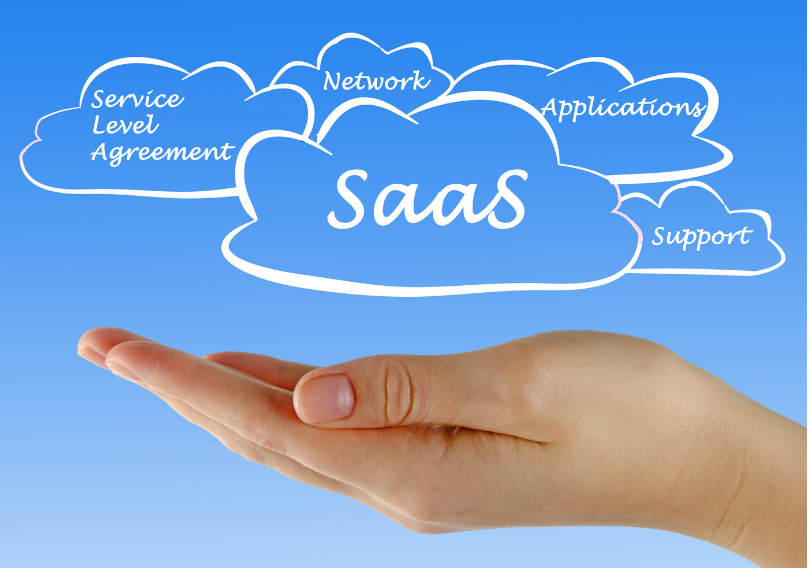
A SaaS, “Software as a Service,” application is a type of cloud computing application that is hosted by a third-party provider and is made available to customers over the internet. SaaS software and apps typically provide customers with business applications which are delivered on a subscription basis. Customers then pay a set fee on a regular basis, usually monthly or yearly, to access the application. Many SaaS apps offer free versions of the software that can be upgraded for more functionality. Many also offer a free or inexpensive trials of the software so users can determine if the app suits their needs prior to committing to a paid plan.
Questions answered in this article include the following:
What are the advantages of using SaaS software?
Incorporating SaaS apps into a business often has many advantages:
- Flexibility: SaaS applications are often highly scalable and can be customized easily to meet the changing needs of a business.
- Ease of Use: SaaS applications are usually easy to set up and use. This allows a business to start using them quickly with minimal effort.
- Automation: SaaS applications automate many manual processes. This saves businesses time and money.
- Accessibility: Saas applications are typically accessible from any device with an internet connection so users can access them from anywhere that has such a connection.
What are the disadvantages of using SaaS software?
SaaS software also has a number of disadvantages:
- Limited Control: Unlike traditional software, with SaaS apps, the user can only access and configure the application as much as the provider allows and cannot customize it beyond that point.
- Inability to Integrate: A business may not be able to integrate SaaS applications with their existing applications and systems. This is particularly true if a business needs to access data from multiple sources.
- Reliability: SaaS software can be unreliable because it is not accessible if the SaaS provider or the internet connection goes down.
- Expense: While most SaaS solutions are affordable, they are mostly subscription-based, so business can end up paying more than intended with multiple subscriptions. When utilizing SaaS software, it may be important to keep track of expenses so they don’t get out of hand.
Is SaaS software a good option for my business?
It depends. It can be, but it depends on the parameters of the business. SaaS software can be very cost effective for many businesses because the business does not need to purchase, install, and maintain the software themselves. If the business requires multiple users to access the application, however, it can potentially become very expensive. Also, since security is maintained by the host company who regularly monitors and updates the software, it tends to be very secure. It is hosted on the cloud, however, which tends to reduce security. In addition, if a business needs a lot of control over the software beyond what a provider allows or if they need to integrate many systems, SaaS software may not be the best solution. Whether SaaS software will be a good option for a business depends on their needs. Before choosing SaaS software, a business must evaluate its needs and whether SaaS software can meet those needs. Only they can decide if SaaS software will work for them.
What are the most common problems Saas software solves?
Below is a list of common problems that SaaS software can help with in addition to a few popular SaaS software solutions a business owner could possibly look into for each problem. This subject will be covered more in-depth with more specific SaaS solutions a business could consider in a future blog.
Collaboration
Businesses have used collaboration tools for a while, but with the onset of Covid and the need to collaborate away from the office, it became essential for teams to effectively work together without being in the same physical space. Google Drive and Dropbox both offer cloud-based file storage and collaboration solutions. Google Drive provides users with real-time, often free, collaboration with shared documents, spreadsheets, and presentations. They also offer a suite of office tools including Google Docs, Sheets, and Slides. Dropbox, on the other hand, provides users with secure file storage, online sharing, and synchronization capabilities.
File Sharing
In conjunction with collaboration, teams often need a way to share files, not only amongst themselves but also with others outside of the team including clients in some cases. Google Drive and Dropbox come to the rescue again with cloud-based file storage and sharing solutions. Google Drive allows users to securely share files with anyone and to control access the their files. Dropbox also enables users to share files quickly and securely.
Project Management
Business teams often need a way to manage projects which are being worked on by multiple members of a team. They need to keep track of who is doing what for a particular project and where in the process the project is. Asana and Trello both offer project management solutions. Asana is a project management platform that helps teams organize and track projects, tasks, and conversations. Trello enables users to create collaborative boards, lists, and cards to help manage and track projects.
Customer Relationship Management (CRM)
Those in sales often have many contacts. In addition, they need to keep track of when to contact who, what was said, and who is in what stage of a sale. In addition, they need to constantly add to that contact list. There’s many components to juggle, and dropping the ball could mean losing a sale. Salesforce and Zoho offer SaaS CRM solutions. Salesforce is a cloud-based platform that helps sales teams manage customer data and relationships. Zoho offers businesses a suite of CRM tools that enable them to manage contacts, customer support, and sales activities.
Analytics
Tracking analytics has become an important part of business. Businesses today need to track how their website is performing and what is converting viewers into customers so they can take advantage of what is working. Analytics are also used by businesses to determine what needs to be changed or tweaked to help businesses grow. Google Analytics and Mixpanel both offer analytics solutions. Google Analytics helps businesses track and analyze website performance metrics such as page views, visitor behavior, and conversions. Mixpanel provides real-time insights into user behavior and engagement.
Email Marketing
Many businesses need a convenient way to keep track of email contacts and put them into groups as well as automate email and newsletter campaigns. In addition, they need to track how well their campaigns do so they can modify their attempts going forward. Mailchimp and Constant Contact both offer SaaS email marketing solutions. Mailchimp helps business manage and automate email campaigns and provides analytics on the campaigns. Constant Contact provides users with customizable email templates and a suite of tools to help business create, send, and track email campaigns.
Online Payments
Online businesses, regardless of whether they supply goods or services, often need a convenient, secure, and reliable way to take payments online. PayPal and Stripe are examples of SaaS software that provides users with ways to both send and receive money, process payments online, and keep track of sales received. They also provide tax documents of income when needed.
Video Conferencing
Covid also made many businesses rethink and come up with alternatives to in-person meetings. They couldn’t happen during the height of the pandemic, and no one knew how long it would be before things would return to “normal”. Hence, video conferencing, which existed prior to Covid, became an essential business tool and has continued to be in wide use ever since. Zoom and Skype offer SaaS video conferencing solutions. They both provide users with high-quality video, audio, and text chat in addition to screen sharing and recording capability.
Document Automation
Businesses needed a way to not only share documents but to allow other parties to sign documents in a secure way that would be legally binding for customers and clients, as well as for onboarding/offboarding employees. DocuSign and HelloSign offer document automation solutions. They both enable businesses to securely send, sign, and manage documents including important contracts.
Human Resources
Businesses often do not have the means to hire a full-time, dedicated HR specialist, but SaaS HR solutions have automated the process for many businesses. Two such programs are BambooHR and Workday. BambooHR helps businesses manage employee data and automate HR processes. Workday provides users with a unified platform to manage payroll, time and attendance, talent, and performance reviews.
Matraex is a custom app development company based in Boise, Idaho, and we would like to be your go-to source for answers to your app development and technology questions. Feel free to contact us, leave a note on our website’s instant messaging feature, or leave us a question on our Google Business Profile. We look forward to hearing from you.
Sign up to receive answers to your questions delivered directly to your inbox!
What Is Artificial Intelligence (AI)?

Artificial Intelligence (also known as AI) is a branch of computer science that focuses on developing computer systems that have the ability to think, work, and react like humans and to perform tasks that normally require human intelligence. This involves accurately and efficiently processing large amounts of data and making decisions or predictions based on that data. AI can also be used to create self-learning systems that can learn from data and improve their performance over time, and more and more businesses are using AI as a way to streamline their operations. Let’s discuss and give some examples of how AI is currently being used. Keep in mind that these examples of AI are only a few of its many uses. These uses also often overlap in one app or piece of technology.
In this article, we will be covering the following types of artificial intelligence:
Image Recognition
Image recognition is a process in which a computer system is able to recognize and identify objects. These objects include people, places, writing, and actions in both still images and videos. With image recognition, a user can take a picture of an object, and AI will tell them who or what the object is. Google Lens, CamFind, and Amazon Rekognition are apps that currently use image recognition technology. While this can be used to benefit the user, in some cases, apps can use AI with user photos in ways their users may not expect. Benefits, unfortunately, sometimes come with negative consequences as well.
Natural Language Processing and Speech Recognition
Natural language processing and speech recognition work hand-in-hand to enable machines to understand, interpret, and generate human language. These technologies are integrated in many home devices that allow you to talk to the machine to turn on your lights and other appliances in your home without lifting a finger and to use Siri or Cortana to answer questions and fulfill requests. Natural language processing and speech recognition are also used in automated customer service and dictation software.
Autonomous Navigation
Autonomous navigation enables vehicles to move from place to place without human intervention. Such systems use sensors, cameras, and mapping data to navigate the environment. In addition, they are often programmed to react to changes such as traffic and road conditions. Autonomous navigation is used in self-driving cars, robots, and drones.
Machine Learning
Machine Learning uses algorithms that enable a machine to learn from provided data and make predictions based on that data. In this manner, systems access data and use it to automatically learn and improve without being explicitly programmed. One app that uses machine learning is Netflix. Netflix recommends content based on the content the user already watched through machine learning. Netflix also uses it to identify and block fraudulent accounts, to detect and reduce piracy, and to target potential customers with personalized ads.
Predictive Analysis
Predictive analysis uses data mining and statistical analysis to identify patterns and trends in data and then to predict future outcomes and behaviors. It can be used to make predictions about customer behavior and market trends. It can also be used to predict the success of a product or service, the likelihood of an event occurring, or the outcome of a particular decision. Weather apps use predictive analysis for more accurate forecasting, financial apps for identifying trends in the market and offering investment advice, and healthcare apps for identifying health risks and suggesting preventive measures.
Robotics
Robotics is a branch of technology that deals with the design, construction, operation, and use of robots as well as computer systems for their control, sensory feedback, and information processing. These technologies are used to develop machines that can substitute for humans and replicate human actions. Starship Technologies is a mobile app that allows users to order food and other items which are then delivered by robots.
Decision Making
During the decision making process, a machine makes a choice between two or more alternatives. It involves gathering information and assessing the available options to make the best decision. Shopping apps like Amazon, Ebay, and Wish use decision making to make personalized product recommendations to customers and to suggest alternatives if the user’s first choice is not available. Health and fitness apps such as MyFitnessPal and Fitbit also use decision making to track and analyze user activity and dietary habits. They then suggest personalized plans to help the user reach their health and fitness goals.
Artificial Intelligence is still an emerging technology, and we’ve only touched the surface of what might eventually be possible. It has and will continue to change how we interact with the physical world, to take over mundane tasks, to optimize operations in many fields, and to help us make better decisions.
Matraex is a premier software and app development company based in Boise, Idaho. Do you have any questions regarding app development? Matraex would like to become your go-to source for answers so you can be an informed consumer. Feel free to contact us, call us at (208) 344-1115, send us a message on our website, or post a question on our Google Business Profile. We’d love to hear from you.
Sign up to receive answers to your questions delivered directly to your inbox!
What Are the Different Types of App Development Companies?

When choosing an app development company for your project, there’s quite a few types of companies you can select from. You can pick a local software development company, a company on the other side of the world, or something in between. App development can be a costly investment, so you may want to do your research to pick the best app development company for your business, organization, or institution. We’re going to discuss the different types of app development companies and some pros and cons of each so you can make an informed decision when you’re ready to choose a developer for your app development project.
The types of software development companies we’re going to discuss are as follows:
Keep in mind that we’re going to describe and compare how these different types of app development companies tend to be, and this comparison is not absolute. You can also look at this chart for a side-by-side comparison:
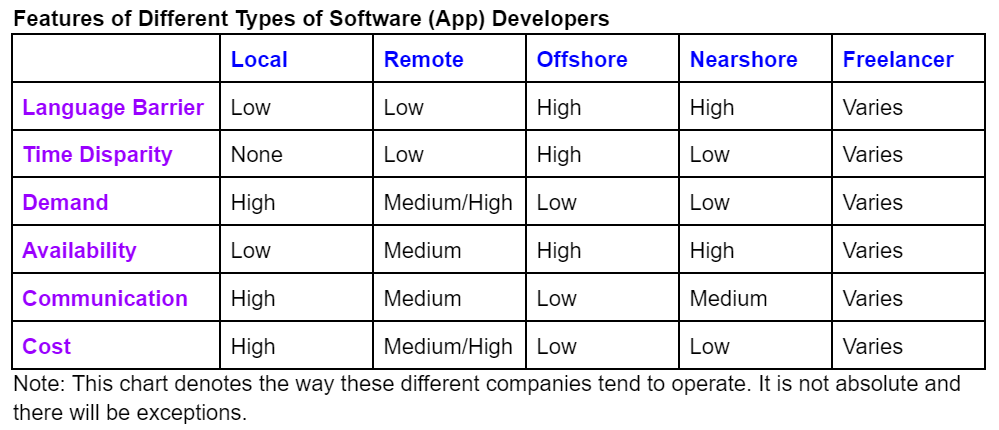
Onshore Development
With onshore development companies, the developers live and work within the United States, though not necessarily in the same state or location as the product owner. With onshore development, the developer and the product owner live within a few time zones of each other and can usually communicate without time differences being a major factor. Both the developer and the product owner are often native English speakers so language tends to not be as much of a barrier. Due to these factors, onshore developers are often in higher demand. They also tend to charge a more premium price than development companies who reside in locations outside of the United States, though that will differ from company to company. It is worth noting that some onshore development companies outsource some of their work to offshore or nearshore developers to keep their costs down. If that is a concern, then you may want to ask your prospective developer about their outsourcing practices prior to hiring them. There are two different types of onshore development companies: remote development companies and local development companies.
Local Development Companies
To summarize, local development companies offer the following:
Language Barriers – Language barriers can exist, but there tends to be fewer problems.
Time Disparity – Both product owner and developer are within the same time zone.
Demand – Tends to be in the highest demand.
Availability – Initial contact may be difficult to achieve, they may have a waiting list, and they may be more selective in the projects they take.
Communication – Regular one-on-one, in person meetings can be coordinated and scheduled. Cost – Tends to charge a premium price for their services.
Remote Development Companies
To summarize, remote development companies offer the following:
Language Barriers – Language barriers can exist, but there tends to be fewer problems.
Time Disparity – No more than a few hours difference in time.
Demand – They tend to charge a more premium price than offshore and nearshore companies. Availability – They may be less available to take on projects than offshore or nearshore companies.
Communication – Remote development companies tend to rely on online communication platforms and phone calls and may sometimes have problems with coordinating meetings.
Cost – Tends to charge a more premium price for their services which is often based on demand.
Offshore Development Companies
To summarize, offshore development companies offer the following:
Language Barriers – A mutual language and idea barrier may exist between the app founder and an offshore developer due to English not being the developers’ native language, or they may have a difficult to decipher accent. This communication barrier can go both ways.
Time Disparity – Often live in totally different time zones with a 10-15 hour difference in time. Demand – Tends to be in lowest demand so they are often easy to acquire.
Availability – Tends to be readily available to take on new projects.
Communication – Meetings may be difficult to arrange and may occur at awkward times. Cost – Often charges a less premium price for their services.
Nearshore Development Companies
To summarize, nearshore development companies offer the following:
Language Barriers – Except for Canada in some cases, English is usually not the developers’ native language, so definite barriers can exist.
Time Disparity – No more than a few hours’ difference in time.
Availability – Tends to be available to take on new projects.
Communication – Remote development companies tend to rely on online communication platforms and phone calls and may sometimes have problems with coordinating meetings.
Cost – Tends to charge a less premium price than onshore developers.
Demand – Tends to be in less demand than local or remote developers.
Freelance Developers
Software development freelancers can be located in the local area or found anywhere within the United States or even abroad. Their availability for meetings with product owners, whether those meetings are in person or via Zoom, can vary depending on the amount of clients the developer has and what office hours they choose to keep. Their price can also vary widely depending on their knowledge, experience level, and location. Freelance developers, due to being single entities and lacking a team, sometimes do not possess the knowledge to complete a software project as specified. Freelancers may also lack the means to test a product thoroughly before it is launched. Due to these factors, a freelancer may sometimes abandon a project before completion or the project is delivered incomplete.
Each freelance developer is different so they can fit anywhere within the spectrum of the others. The biggest thing to note, however, is that they may not have the knowledge or skills to complete the job they were hired for.
We hope that this information helps you find the right software developer for your unique project and circumstances. Matraex is an app development located in Boise, Idaho, and we would provide the app development answers that you need so you can be an informed consumer. Check out Matraex’s other blogs for answers to other questions you may have. Ones that may be of particular interest to you include “How Much Does a Custom App Cost?” and “What Are Problems that Occur When Developing an App?” Can’t find an answer to your question? Contact us directly or give us a ring at (208) 344-1115. Your question may even become an upcoming blog.
Sign up to receive answers to your questions delivered directly to your inbox!
What Is an MVP and Why Should I Consider One?
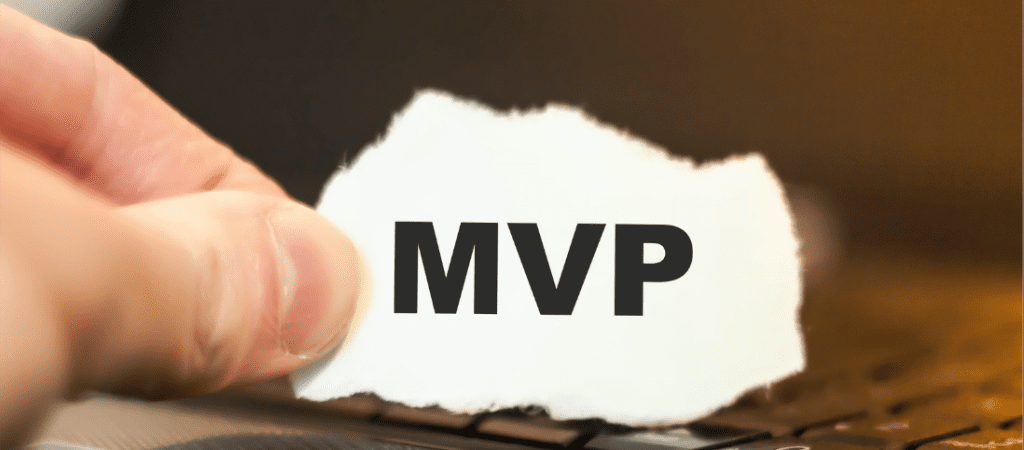
According to Techopedia, an MVP (minimum viable product) is “a development technique in which a new product or website is developed with sufficient features to satisfy early adopters. The final, complete set of features is only designed and developed after considering feedback from the product’s initial users.”
In other words, an MVP contains 80% of the app’s value with only 20% of the features. It is an initial version of an app that will provide users with what is necessary to perform the primary functions of the app, but without the functionality, the “bells and whistles” that it is likely to acquire later on. Many of those later functions will be determined by feedback from the users that the app is intended for.
This article will answer the following questions about MVPs:
What features are usually included in an MVP?
An MPV will have the basic content that is required for a user to navigate through the app including these essential features:
- Login/Registration. This allows users to create accounts and log in to the app. This is important in an MVP because it allows users to store and access their information as well as customize their experience.
- Home Screen. This provides users with an overview of the app in addition to quick access to the most popular features. This allows users to quickly orient themselves with the app and find what they are looking for.
- Search: This feature allows users to quickly and easily search for content within the app so they can find what they need without having to scroll or navigate through the app.
- Notifications: This feature sends users reminders and updates about the app. This helps to keep users engaged and up-to-date on the app’s content.
- Customer Support. So users can get help or support when they encounter problems with the app. This helps to ensure that users have a positive experience with the app.
- Basic Analytics. This will track user behavior and help to make decisions based on data.
- Revenue generation/checkout capability (when needed). This feature allows for users to pay for services and products that are offered through the app.
- Social integrations, which allow users to interact with you or with each other.
What features are included in the MVP are determined by the unique needs and requirements of the app visionary who has envisioned the software and the end users. The product user also helps to determine what features are necessary to have in the app right away.
What is not usually included in an MVP?
Non-essential or expensive content is generally not included in the MVP but will be added later based on demand and the feedback of the app’s users. This can include any of the following:
- Custom design. It tends to be costly and time consuming to implement and most users will not notice it if it is missing.
- Integrations with third-party services. These can also be expensive and difficult to set up,and they often require additional development down the line.
- Scale support, which consists of different methods of support, determined on the type of support and how in-depth the support is that one needs.
- Value proposition, which, according to Investopedia, is “the value a company promises to deliver to customers should they choose to buy their product.” This tends to be left out because, during the MVP stage of an app, the final value of the app to its users is to be determined.
- Differentors, which are features that set you apart or make you unique from your competition.
- Customized User Flows that allow users to personalize their app experience but are not necessary for the primary functionality of the app.
- Advanced analytics and reporting. This type of feature often requires a lot of data and can be time-consuming to set up correctly.
- AI and machine learning. They are both complex technologies, and it can take a lot of time and effort to implement them correctly.
If any of these features are essential for the primary use of the app, they would be included in the MVP. What features are included in the MVP is determined by the unique needs and requirements of the app visionary who has envisioned the software and the end users. The product user also helps to determine what features are necessary to have in the app right away.
What are the reasons to consider an MVP?
There are many reasons for a business, organization, or institution to consider launching an app as an MVP.
- It’s cost effective. An MVP allows the app founder to test the viability of a product while avoiding the expense required to develop a full-featured product. This can help to have money and resources.
- It’s quick to market. An MVP can be released quickly. Then the product owner can make adjustments to the app based on customer feedback.
- It allows for iteration. An MVP allows the product owner to quickly test and change features based on user feedback. They can even pivot the purpose of the app according to feedback. This allows them to improve the app quickly and efficiently.
- It helps the app founder to assess their market. An MVP allows the founder to see if there is a market for the app by gauging user interest.
- It encourages early adoption. An MVP encourages early adopters to try the app and give feedback, which can help the founder to make improvements and increase the app’s value.
- It focuses on core features and, by doing so, eliminates unnecessary features. This helps to create a final app that is simple and user-friendly.
- It allows for early testing. This allows for users to test the app early in the app development process and make improvements based on user feedback.
- It gives the app founder a competitive edge because it allows you to get the app quickly to market and establish a foothold in that market.
- It makes it easier to find and receive funding. Investors are more likely to invest in an app that already has a proven concept and a user base.
- It allows the product owner to make informed decisions about the app, its features, and its pricing. This can help the app founder make the most of their investment and increases their chances of success.
How do I prepare an MVP?
There are several steps that a product owner can take that will help them create an MVP for their app:
- Identify the problem that the app is intended to solve. The product owner needs to understand the needs and pain points of the user and then use the information to define the problem that needs to be solved. The product owner can determine these needs through surveys, interviews, and focus groups. Additionally, the product owner should conduct research to determine what potential solutions are already on the market. This will help the product owner determine if his app has a market and if he could potentially find a less costly solution for the problem.
- The product owner needs to then define the goals of the MVP and what the app should accomplish. This should be done in close collaboration with stakeholders, including customers, investors, and the development team. These goals should be specific and measurable so they can be tracked over time.
- The app founder needs to brainstorm a list of features that should be included in the app and then prioritize the features based on their importance to the user. This can be done by creating a feature matrix that evaluates each feature on a scale of importance and value. Any feature that is deemed indispensable should be a part of the MVP.
Can an app that starts as an MVP become successful?
Absolutely! Many well-known or popular apps started as MVPs. If you choose to start your app with one, you’ll be in good company. Apps that started as MVPs include the following:
- Facebook. Mark Zuckerburg initially designed Facebook for his fellow classmates who attended Harvard University to connect. He then expanded it to other universities while adding additional features, and it was eventually released to the public.
- Airbnb. The founders of Airbnb, Brian Chesky and Joe Gebbia, originally created Airbnb to rent out an air mattress in their loft in San Francisco for an upcoming conference. Now, people across the world use it to find and rent accommodations.
- Amazon. When Jeff Bezos started Amazon, it was designed for him to purchase books from distributors and then ship them to customers when he received orders. Now, Amazon sells products worldwide, and many merchants use it to conveniently sell their products.
- Uber. Uber originally started as “Uber Cabs”. It was designed to solve the difficulty in locating taxis in the traditional way. Now, anyone can drive for Uber and many additional features are offered. Those features include tracking your drive and cost-estimating.
Matraex is a premier desktop and mobile app development company based in Boise, Idaho. Do you have other questions that you need answered before going through with an app project? Take a look at our blog for answers to your questions. Particular blogs that may interest you include “What Are Problems that Occur When Developing an App?” and “How Much Does a Custom App Cost?” If you have any questions that have not yet been answered in one of our blogs, contact us, give us a call at (208) 344-1115, or leave a question on our Google Business page. We want to make sure that all of your questions are answered before you start designing your custom app so you get exactly what you’re searching for.
Sign up to receive answers to your questions delivered directly to your inbox!
How to Protect Your Intellectual Property

In the beginning phases of developing an application, there are many things to keep in mind in order to protect an idea and the process through which the idea is implemented. One important first step is setting up possession of code. By setting this up at the beginning of the process, you can confirm ownership which will give you ultimate control over what happens during the project process.
What is Possession of Code?
Possession is defined as, “the state of having, owning, or controlling something.” This is no different within the world of software development. To avoid issues down the road, setting up access to the current code base is best practice. To understand this process, it can take a bit of training and research but it is well worth it to protect your project.
Time and time again, individuals run into the issue of obtaining their code from a previous developer when switching to a new freelancer, internal developer, or third party development firm. If you have possession of your code, you have access to invite new developers or revoke past developers if there comes a time when you no longer want a developer to make changes to your project.
NDA
Another way to protect your code is through an NDA (non-disclosure agreement). While ensuring that you have obtained possession of your code is important, an NDA is an equally important next step.
What is an NDA?
An NDA is a non-disclosure agreement. Its purpose is to create the legal framework that protects you and your application idea from being shared with anyone else. This article is a great resource that will tell you everything you need to know when it comes to non-disclosure
Do I need an NDA?
It is best practice to have an NDA in place when dealing with anything pertaining to intellectual property. An NDA ensures confidentiality and protection. Without an NDA, you are at risk of your idea being leaked.
Your ideas are an extension of your creativity and keeping them protected is of utmost importance. Ensuring possession and ownership and signing an NDA are two ways that you can ensure protection and have peace of mind and you dive into the world of software development.
Agile and Waterfall Methodologies in Software

Waterfall and Agile are well known approaches in software development. They are two unique methodologies providing different directions for various types of projects.
Agile Software Development – a type of development framework that expects the need for flexibility and applies a level of efficiency to the delivery of the finished product through consistent deliverables & communication.
Agile
- Frequent meetings
- Works well in conjunction with MVP
- High flexibility
- Short term deadlines – quick deliverables
- Collaboration between parties
- Reduced risk
- Cost effective
This graph shows the flow of an agile timeline. There is constantly a new deliverable and after each deliverable, there is communication between parties to review what is working and what needs to shift in order to continue improving the product. The time between each deliverable is typically two to four weeks, although it can be shorter. Due to consistent communication between parties, agile is more cost effective because the project can shift easily and frequently.
Waterfall Software Development – With a waterfall methodology, the scope and requirements of the project are defined upfront. The client receives large batch deliverables at the end of each development phase.
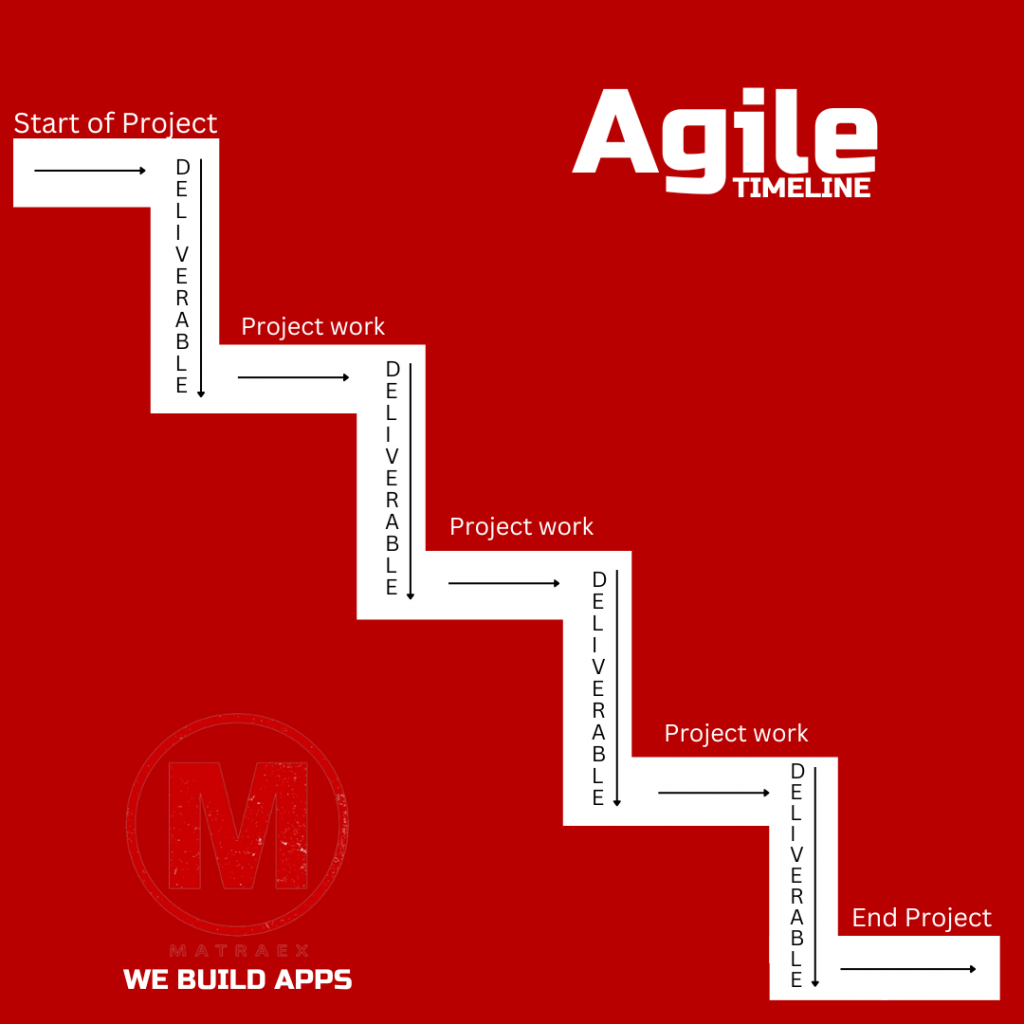
Waterfall
- Goals set from the beginning
- Requirements are clear and fixed
- Infrequent meetings
- Complete deliverables before moving onto next phase
- Low flexibility
- Higher cost
Looking at the graph to the right, you’ll see that Waterfall project timelines are longer than Agile. While working on a Waterfall project, there is often less communication as the requirements are less flexible in the beginning phases of the project. Due to this, there is more risk associated because of less flexibility to change the product. In Waterfall, each stage of the project needs to be completed before moving on to the next step.
Agile is more commonly used today because of the flexibility, cost efficiency, and reduced risk associated with this methodology.
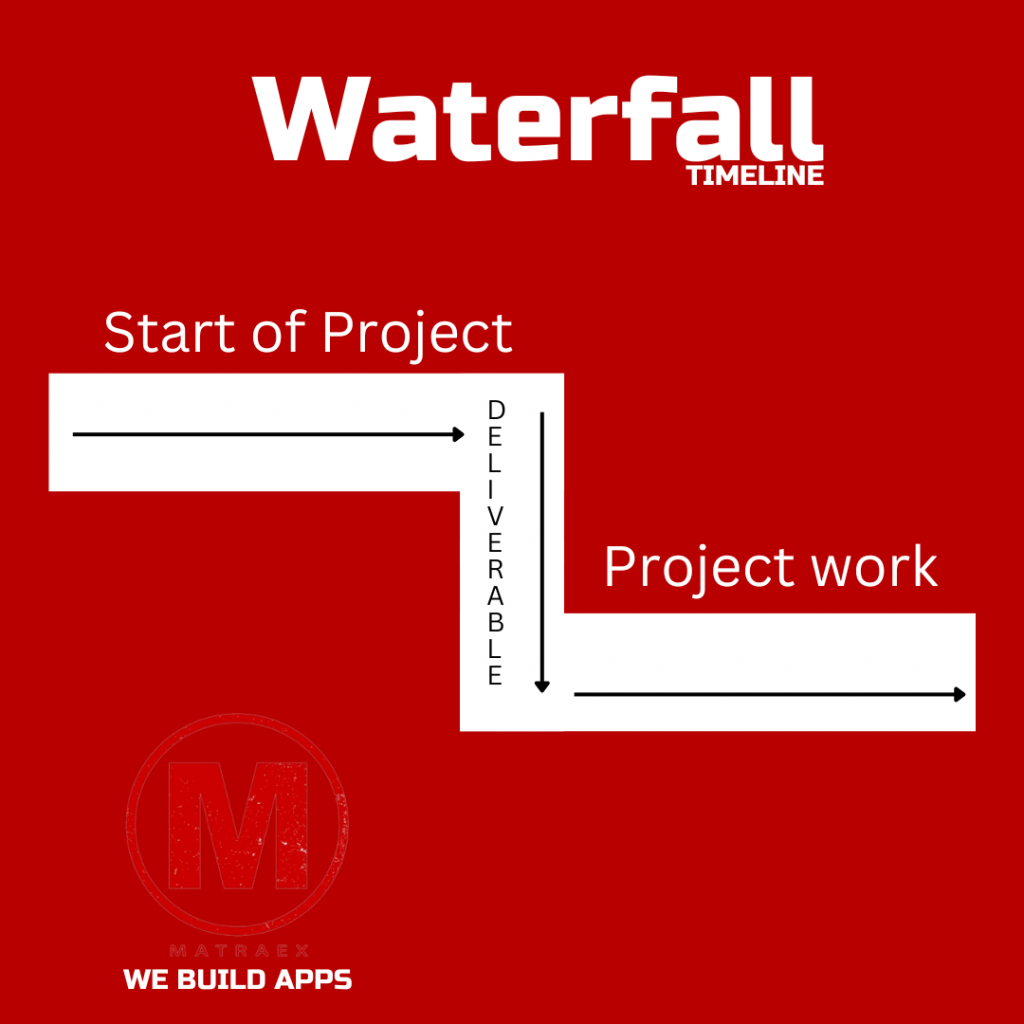
Does Your Business Need a Mobile App?

Mobile apps have increasingly become an integral part of the digital landscape. For many businesses, they are an indispensable asset and for others, the question still remains: “Should my business be utilizing a mobile app?” This article discusses a few things to consider before jumping into the world of app development and will give a better understanding of things to consider when deciding if an application is necessary for your business.
- Your audience
- The value of your app
- Your competitors
- Long term app support
- Current website
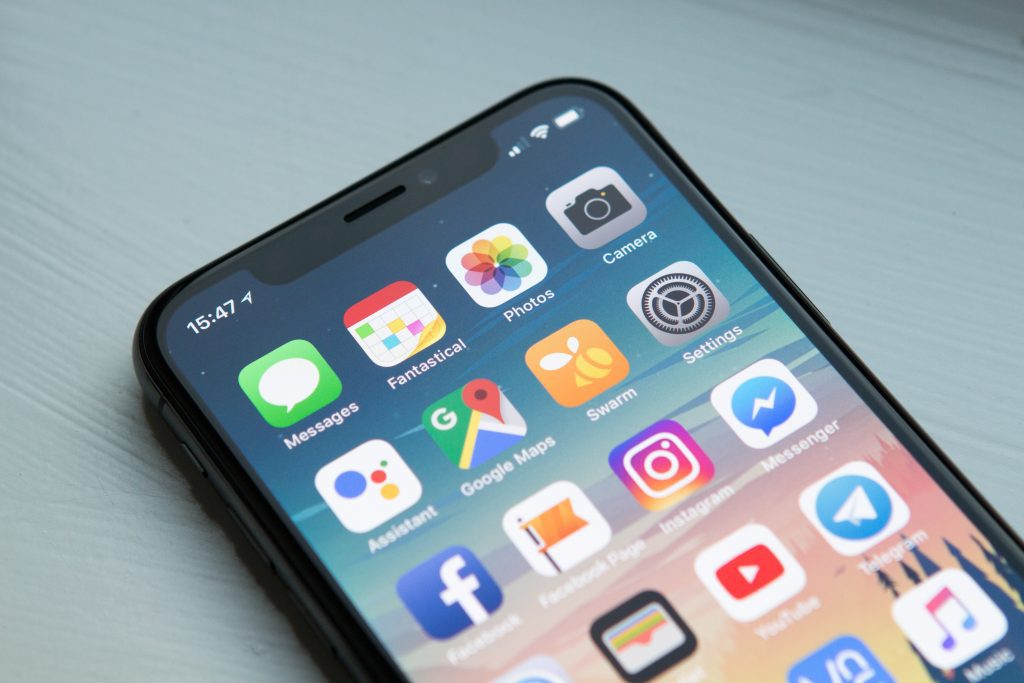
Your Audience
Consider who your audience and ideal customers are. Here is a great article from HubSpot that breaks down exactly how to figure out who your target audience is.
The Value of Your Mobile App
An app should add inherent value to both a business and its customers. Here are a few ways an app can add value:
- New Revenue
- Selling goods and services
- Process payments, track orders, and manage inventory
- Sell a new product
- Offer follow-up goods
- Build Relationships
- Connect to your customers through push notifications about new products, services, special offers, and events.
- Collect customer feedback and build relationships
- Better customer service
- Reduce Expenses
- Can help save time
- Answer questions
- Automate processes
Long Term App Support
Apps require maintenance of follow-up features and updates. Once an app is developed, there may be bug fixes to keep up with along with improving basic functionality of the app as time goes on. Consider the time commitment and cost associated with keeping an app updated.
Current Website
When deciding if you need a mobile app, consider whether you are able to accomplish what you need by adding small changes to your website. A well optimized website can provide many of the same functions as a mobile application. If you already have a website, think about the additional benefits a mobile app will provide and ask yourself the question, “Should my business be utilizing a mobile app?”
All in all, developing an app can be a very positive addition to your business when it adds value and helps you connect with your consumers. If you are interested in looking at the next steps, talking with a professional app development company is a great place to start in order to assess your business needs and determine if an app is right for you.

Your software developer is quitting: now what?

So the truth is out! The developer that knows everything about your project is not going to be around to finish it.
You may have cursed a bit under your breath and tried to quickly maneuver to keep them on board – however, you are reading this article because you now know it is up to you to confirm you have possession of your project. It is up to you to take control of the software so you can direct it and secure the future of it. Here is how you do it.
- First of all, don’t freak out, a calm and professional response to the news is the best way to encourage a smooth transfer of all project assets and assistance identifying ‘forgotten’ assets.
- Second, create a shared ‘offboarding’ document and / or folder where you can coordinate the process of collecting information about your project.
- Request information from your developer – Let them know that the most important part of their offboarding is to help you understand the project – so you can help the next person take it over.
- Confirm that you have the information you are looking for – it can be tempting to just assume you have it, but by taking the time to verify it, you will identify things that are missed and save headaches later.
Don’t Freak Out
Why is this a step? Because we have found that some of our past clients needed this reminder. Too often we hear of hasty hire or poorly orchestrated offboarding while the manager spends time realizing that the project was not going to be done the way they had previously assumed. Often, the decision will be made to try to ‘get it all done’ in the next two weeks. They drive the developer to spend every moment of their last two weeks getting writing code. This should not be the first priority! The first priority should be to ensure that the possession of the project is fully in the control of your company and the company can continue development of the project in the future.
One of the reasons that we see managers ‘Freak Out’ at this stage is because they have not previously recognized that they should have set their project up in a way that made sure that the project was already in the possession of the company. Ultimately, any project that was going to be owned by your company had to be in company possession anyway, right? So this is a good thing – we are going through the process of putting your project in your control – so your project will survive this ‘developer change’ and any ‘developer changes’ in the future.
Your systematic and practical approach to offboarding your current developer will result in a strong understanding of your project and an improved ability to select the ideal replacement when you restart your project. The possession you end up with will give you the confidence to restart and finish the project in the future.
Create a shared offboarding folder
Create a shared folder where you can work with your developer over the next days and weeks to collect information about your projects. You will want to create the area yourself and setup the structure to have the information you want.
I use Google Documents because the ability to collaborate is better than any other tool, but what is important is that it works for you and your developer and you are able to see each other’s work. Create several documents and give your developer access so they can make changes where you can see them. I recommend that you create the following documents at a minimum – be sure that each of the folders has permissions which allow your developer to make changes:
- Document: Offboarding Checklist / Instructions
- Document: Offboard TeamMemberName – MM/DD/YYYY – Projects / Assets / Credentials
- Folder: Project Asset Uploads
- Folder: Recordings
I have created an example (with some sample entries)
Request the following from your developer:
- Fill out the offboarding document with credentials and links to each project and project source
- List all code repositories and transfer ownership to me
- Provide me with access to your workstation
- Record a video of you working through opening, making a simple development change and then deploying
- Record a video showing the workstation and development environment and configuration
- Record a video explaining for each project what your next steps and recommendations would be
Confirm possession and control of your code
- Understand and confirm your understanding of all project assets
- Test credentials and confirm owner level access to all project assets
- Confirm project source links and documentation, add notes and request updates
- Review recordings and request additional recordings.
- Time permitting: Request a review / audit of code / transfer confirmation from a third party
Marketing Websites vs Web Applications

We are often asked if we build “websites” – yes we do, but there is nuance to the answer. The websites that we build are better defined as “Web Applications”. And a “Web Application” is different from another type of website – a “Marketing Website”. How are these two different? In short: A Marketing Website presents information about a topic or business and a Web Application helps users get something done. The table below describes many of the differences between a Marketing Site and a Web Application. Since Matraex is the #1 Web Applications development firm in the Boise market – people looking for a local ‘Website Designer’ will often reach out to us – I added some links to the Google My Business page for several long term and reliable local resources to help people understand the different companies that comprise these different categories of “Website” builders.
Marketing Website Developers
Web Application Developers
- Matraex, Inc (this is us!!)
- Vynyl
- Ventive
The key differences between a Marketing Website and a Web Application
| Marketing Website | Web Application | |
|---|---|---|
| Purpose | A marketing website’s goal is to provide information, most of these are corporate business sites providing details of a company’s offerings with resources, contact information and links to related industry | A Web Application is a website that helps a user accomplish something through its interfaces. |
| Development process | A Marketing Website can be developed by creating and approving a design, building on the information and content and then applying the design to the content. | A Web Application starts as an idea and forms into a list of features (a roadmap) with the most important features first. The developers implement the items in order of the roadmap. More sophisticated applications often have multiple environments so the complex logic can be tested be approving features to be moved to launch. |
| Time to launch | An entry Marketing Website can take between one week and one month depending on complexity and number of pages. | An entry Web Application MVP (minimum viable product), can take 2 to 6 months to launch. |
| Time Requirements | Most time goes to creating content and managing SEO. A larger one time cost to design the interface and layout is a close second | Most time is spent in developing code to create features and functionality. |
| Team | A project manager, a content creator, and a front-end developer. | Project manager and a full stack developer. Larger teams will have roles split into back-end and front-end developers. |
| Hosting Cost | Less expensive – MANY SOLUTIONS! | More expensive – the hosting is often decided by the technology stack and development group. Modern applications use cloud based hosting which only charge for usage, but can scale to high levels |
| Common Technology Platforms | WordPress, Wix, Square | PHP, React.js, NodeJS, ASP.NET, java |
| Specialties | HTML / CSS / Design / Front End SEO / Content Generation / Design / Copywriting | Programming / Database / Logic / Backend Testing / User Experience / QA Innovation / Security |
How App Development is Done
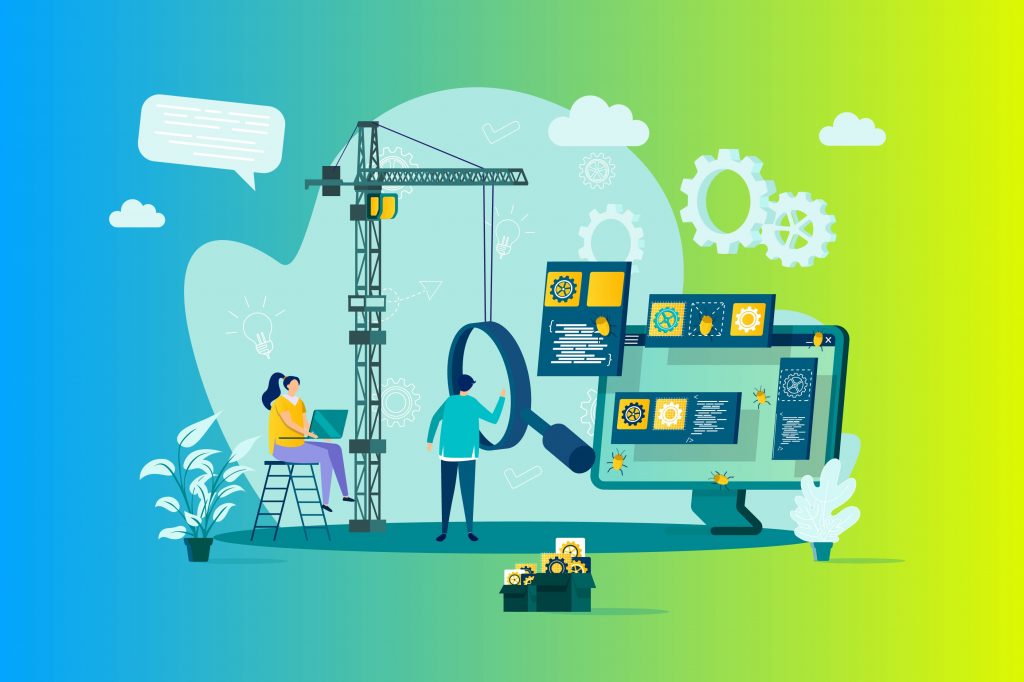
Application development UI illustration in flat design. Mobile app building concept banner with industrial crane and team of workers developing and constructing applications. App development company.
There is a constant need for apps to help employees and everyday people complete tasks. Developing an app of your own can be both helpful for the general workforce and lucrative for yourself. The following is a step by step approach for how app development is done.
1. Brainstorm
The first step in developing an app is to decide which kind you should make. Take note of the different tasks you do at work or at home and see if any of them can be automated. Write down all the ideas that come to mind, even the bad ones. In my experience, bad ideas that don’t get ignored lead to good ideas, so write them down. Take a look at other apps on the market and determine if they are lacking anything, or if there are ways they could be better. All of this will help you pinpoint what sort of app you should develop.
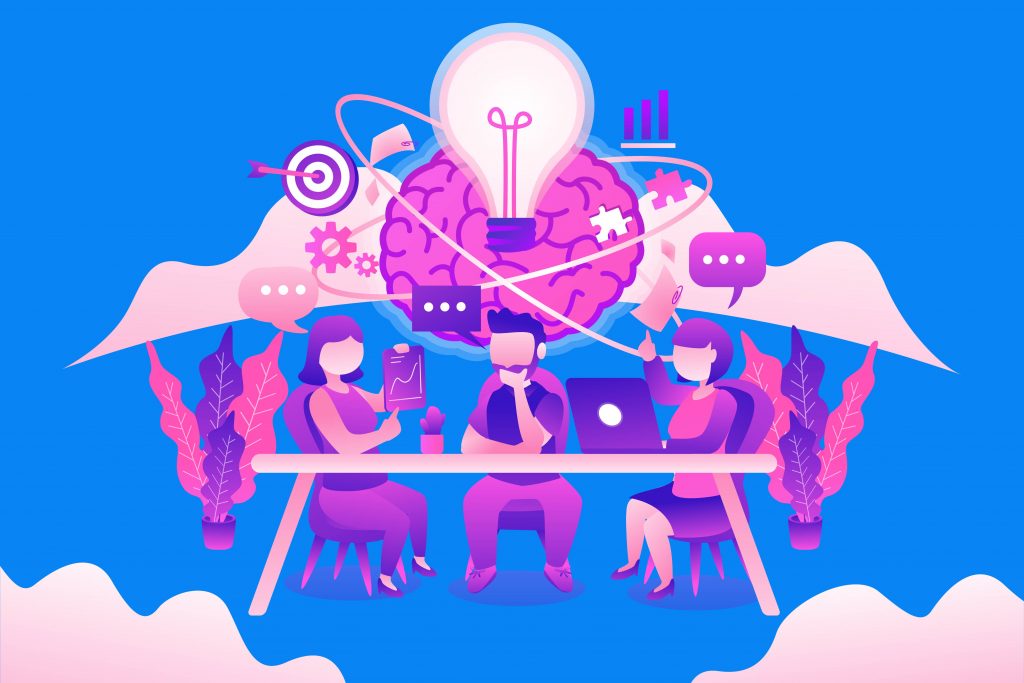
2. The Design Document
Once you know what kind of app you want to build, the next step is to put it into words in the form of the design document. The purpose of this document is to keep the development project on track. The design document outlines all of the features and abilities you want your app to have. For more information on writing a design document click here.
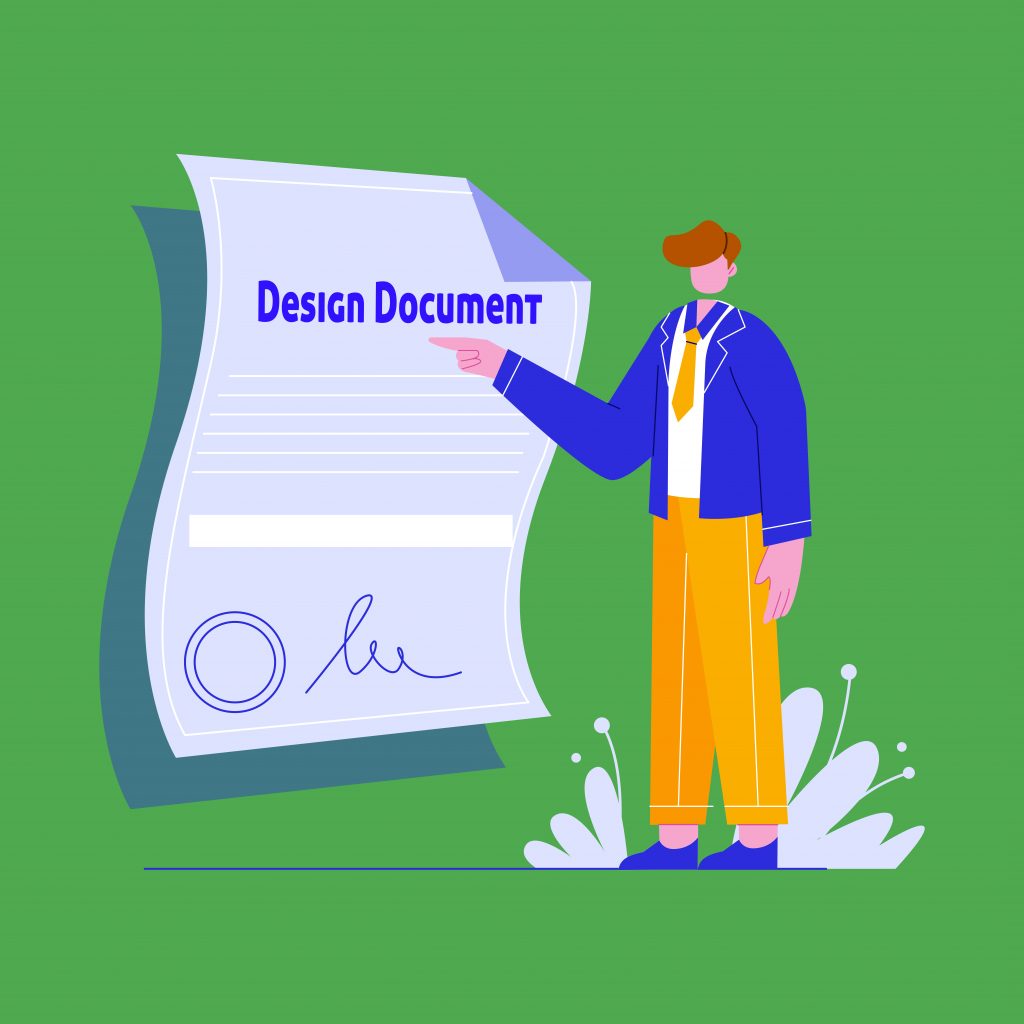
3. The Prototype
Now you’re ready to actually build the app. You’ll start by creating the prototype. This will be a rudimentary version of your app. At this point, the main concern is to get all of the functionality in place. The prototype doesn’t need to be beautiful, the art and design of the app (while important) will be one of the last things to work on.
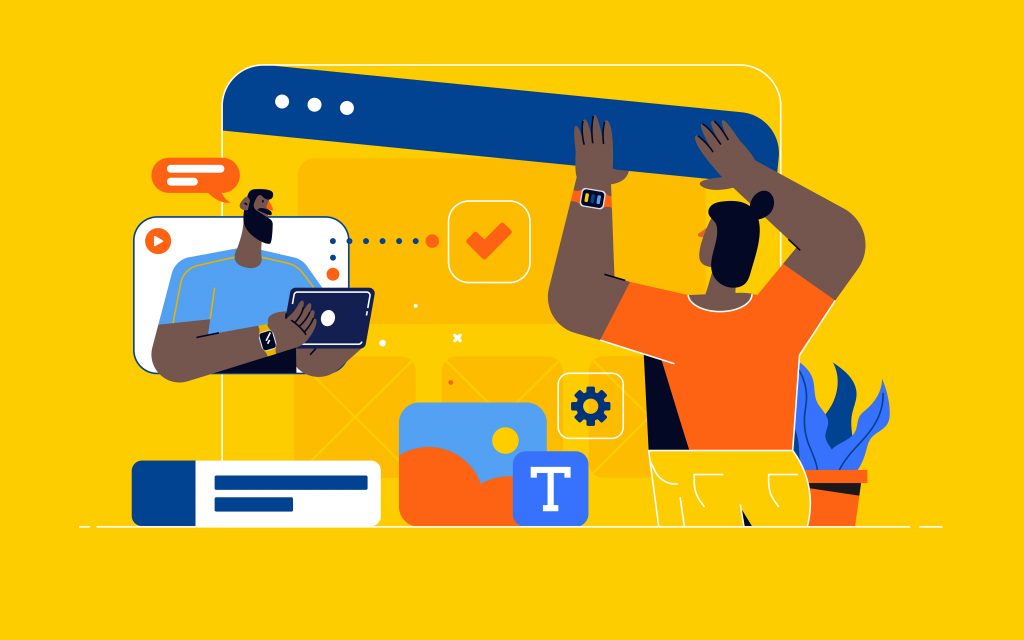
4. Testing the App
There will be a plethora of bugs to work out. The bugs come from mistakes in the code, weird usage the app’s design didn’t account for and other reasons. Testing will help you find the mistakes so you can fix them before your end users find them. Try to throw every conceivable scenario at your app to make sure it can handle them properly. When you’re working so close to an app, it can be hard to step back and spot problems that fresh eyes could find. For this reason, you’ll want to have friends and family test your app to further uncover any bugs.
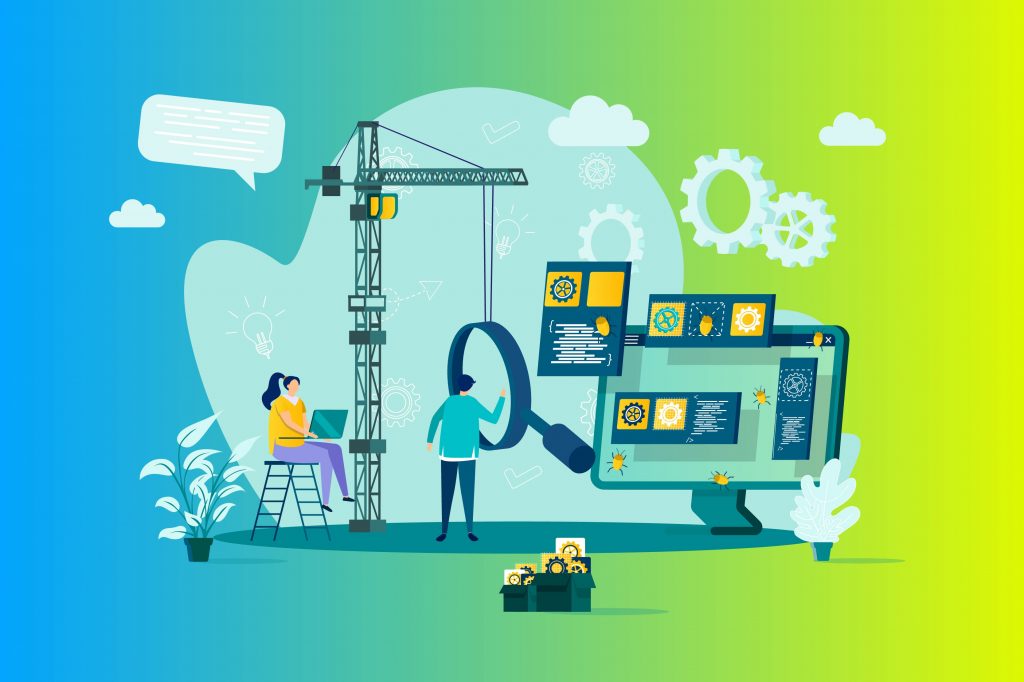
5. Polishing the App
Now that you’ve finish testing and fixed all the bugs you were able to find, you’re ready to polish your prototype into a finished app. This includes choosing attractive color schemes, borders, buttons and art that you want to include in your app, as well as organizing your menus in a way that has a logical flow. Typically a skilled UI designer would work on this part, but that would add significantly to the cost of your app. If a UI designer is not within your budget then at the very least make sure your app is both easy to use and pleasing to look at.
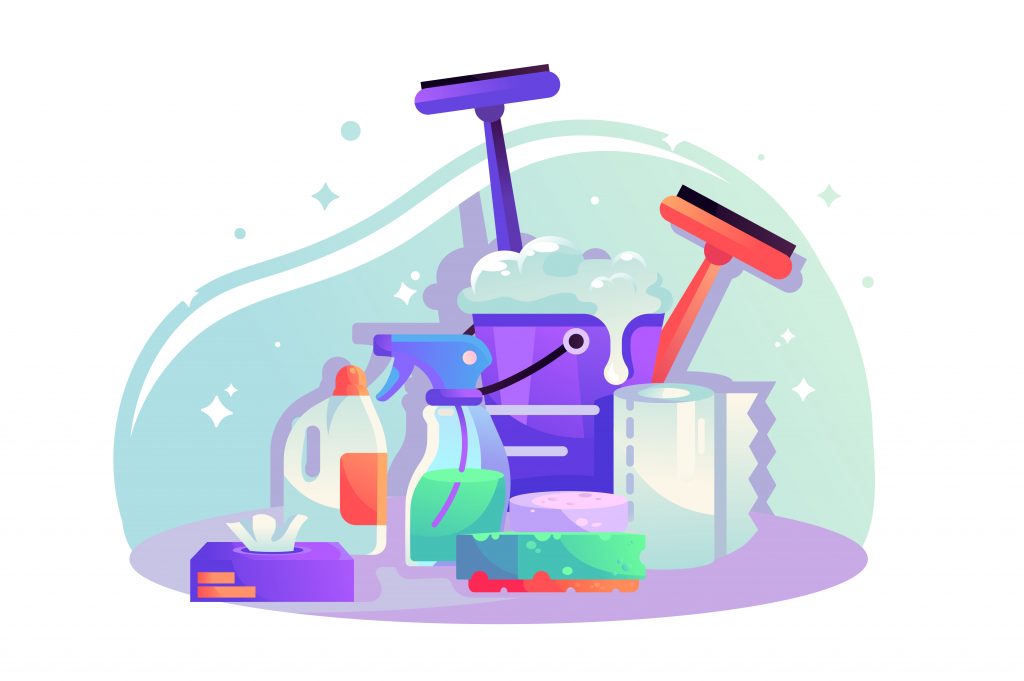
6. Distribution
Now your app is finished and ready for distribution. There’s a few ways you can get your app to the masses. If you designed your app for a particular operating system, there are online digital stores you’ll be able to sell it in. For example, if you designed your app for Android devices, you’d be able to sell it on the Google Play Store or even on your own website. Document your apps features and include tutorials and screenshots. If you distribute and sell the app through your own personal website you’ll need both a server and a decent digital payment system, respectively.
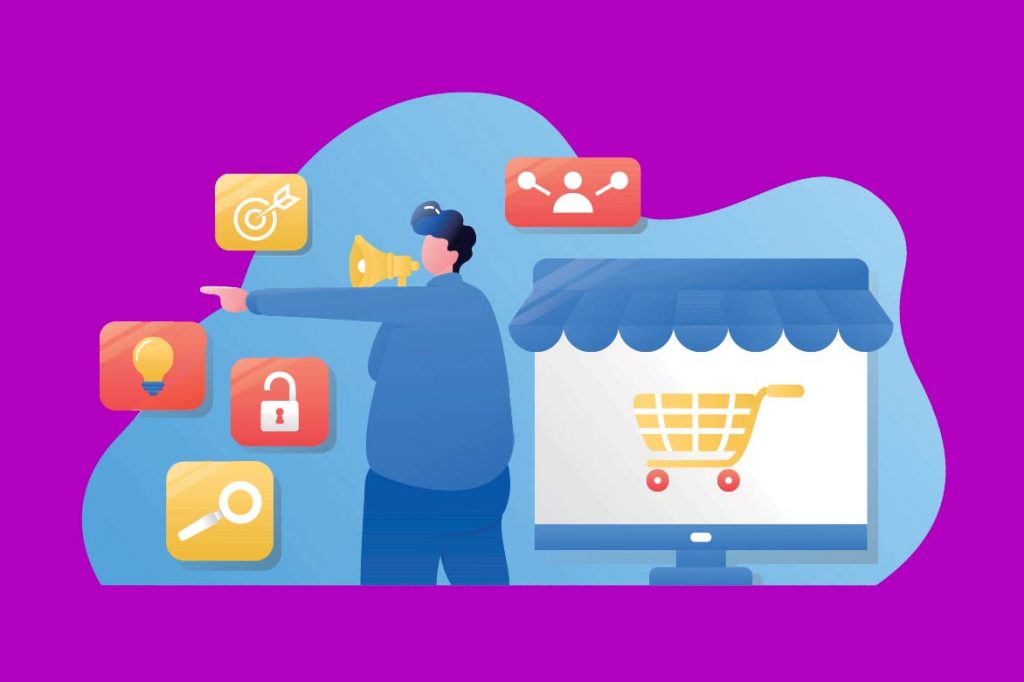
If you have an idea for an app and would like our team of developers to build it for you, contact us by clicking here and get started with a free one hour consultation.
